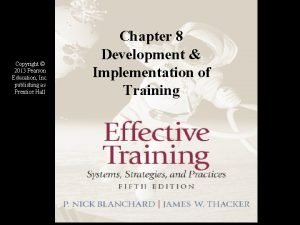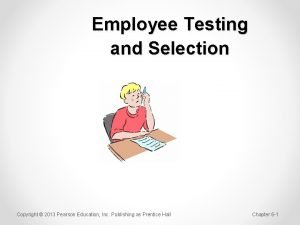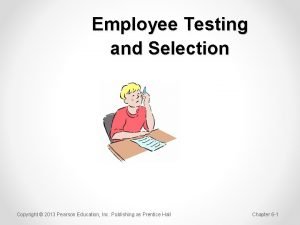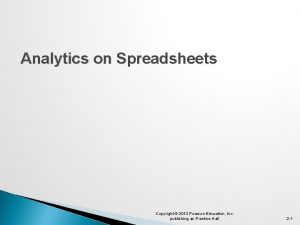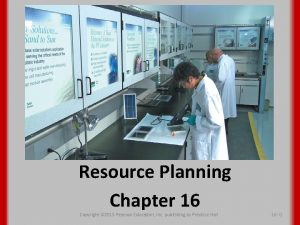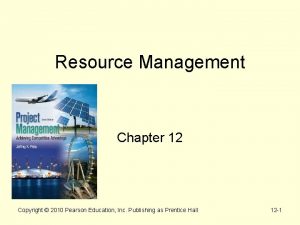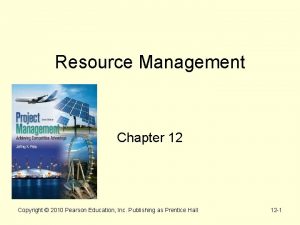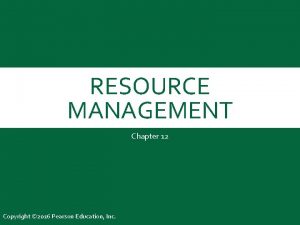Chapter 12 Resource Management Copyright 2013 Pearson Education

















- Slides: 17

Chapter 12 Resource Management Copyright © 2013 Pearson Education, Inc. Publishing as Prentice Hall 12 -01

Chapter 12 Learning Objectives After completing this chapter, students will be able to: �Recognize the variety of constraints that can affect a project, making scheduling and planning difficult. �Understand how to apply resource-loading techniques to project schedules to identify potential resource overallocation situations. �Apply resource-leveling procedures to project activities over the baseline schedule using appropriate prioritization heuristics. �Follow the steps necessary to effectively smooth resource requirements across the project life cycle. �Apply resource management within a multiproject environment. Copyright © 2013 Pearson Education, Inc. Publishing as Prentice Hall 12 -02

Types of Constraints q. Time q. Resource q. Mixed Copyright © 2013 Pearson Education, Inc. Publishing as Prentice Hall 12 -03

Resource-Loading Chart Demonstrating Overallocation FIGURE 12. 3 Copyright © 2013 Pearson Education, Inc. Publishing as Prentice Hall 12 -04

Resource Usage Table FIGURE 12. 5 Copyright © 2013 Pearson Education, Inc. Publishing as Prentice Hall 12 -05

Example of Resource Usage Table with Overallocation FIGURE 12. 6 Copyright © 2013 Pearson Education, Inc. Publishing as Prentice Hall 12 -06

Resource Leveling (Smoothing) A multivariate, combinatorial problem Objectives To determine the resource requirements so that they will be available at the right time To allow each activity to be scheduled with the smoothest possible transition across resource usage levels Copyright © 2013 Pearson Education, Inc. Publishing as Prentice Hall 12 -07

Prioritization Rules for Leveling v. Smallest amount of slack v. Smallest duration v. Lowest ID number (FCFS) v. Greatest number of successor tasks v. Requiring the most resources Copyright © 2013 Pearson Education, Inc. Publishing as Prentice Hall 12 -08

General Procedure for Leveling 1. Create a project activity network diagram 2. Develop resource loading table 3. Determine activity late finish dates 4. Identify resource over allocation 5. Level the resource loading table Copyright © 2013 Pearson Education, Inc. Publishing as Prentice Hall 12 -9

Creating Resource Loading Charts (1/4) Display the amount of resources required as a function of time. 4 B 5 Res = 2 0 A 4 Res = 6 5 D 9 Res = 7 9 E 11 Res = 3 1. Start with a network diagram 4 C 7 Res = 2 Copyright © 2013 Pearson Education, Inc. Publishing as Prentice Hall 11 F 12 Res = 6 12 -10

Creating Resource Loading Charts 2/4 Activity Resource Duration A 6 4 B 2 1 C 2 3 D E F 7 3 6 4 2 1 ES 0 4 4 Slack 0 0 4 LF 4 5 11 5 9 11 0 0 0 9 11 12 2. Produce a table that shows the duration, early start, late finish, slack, and resource(s) required for each activity. Copyright © 2013 Pearson Education, Inc. Publishing as Prentice Hall 12 -11

Creating Resource Loading Charts 3/4 3. Draw an initial loading chart with each activity scheduled at its ES. Resources 8 6 4 A D B 2 C 2 4 6 8 10 Project Days Copyright © 2013 Pearson Education, Inc. Publishing as Prentice Hall F Resource imbalance E 12 14 12 -12

Creating Resource Loading Charts 4/4 4. Rearrange activities within their slack to create a more level profile. Splitting C creates a more level project. Resources 8 6 4 A D B 2 C 2 4 C E 6 8 10 Project Days Copyright © 2013 Pearson Education, Inc. Publishing as Prentice Hall F 12 14 12 -13

Key Parameters in Multi-Project Environments Ø Schedule slippage Ø Resource utilization Ø In-process inventory Copyright © 2013 Pearson Education, Inc. Publishing as Prentice Hall 12 -14

Prioritizing Resource Allocations in Multi-Project Environments First come first served Greatest resource demand Greatest resource utilization Minimum late finish time Mathematical programming Copyright © 2013 Pearson Education, Inc. Publishing as Prentice Hall 12 -15

Summary 1. 2. 3. 4. 5. Recognize the variety of constraints that can affect a project, making scheduling and planning difficult. Understand how to apply resource-loading techniques to project schedules to identify potential resource overallocation situations. Apply resource-leveling procedures to project activities over the baseline schedule using appropriate prioritization heuristics. Follow the steps necessary to effectively smooth resource requirements across the project life cycle. Apply resource management within a multiproject environment. Copyright © 2013 Pearson Education, Inc. Publishing as Prentice Hall 12 -16

Copyright © 2013 Pearson Education, Inc. Publishing as Prentice Hall 12 -17
 2013 pearson education inc
2013 pearson education inc 2013 pearson education inc
2013 pearson education inc Performance gap
Performance gap 2013 pearson education inc
2013 pearson education inc 2013 pearson education inc
2013 pearson education inc 2013 pearson education inc
2013 pearson education inc 2013 pearson education inc
2013 pearson education inc 2013 pearson education inc
2013 pearson education inc 2013 pearson education inc
2013 pearson education inc 2013 pearson education inc
2013 pearson education inc 2013 pearson education inc. answers
2013 pearson education inc. answers 2013 pearson education inc. answers
2013 pearson education inc. answers 2013 pearson education inc
2013 pearson education inc 2013 pearson education inc
2013 pearson education inc 2017 pearson education inc
2017 pearson education inc Copyright pearson education inc
Copyright pearson education inc 2010 pearson education inc
2010 pearson education inc Copyright 2009
Copyright 2009






